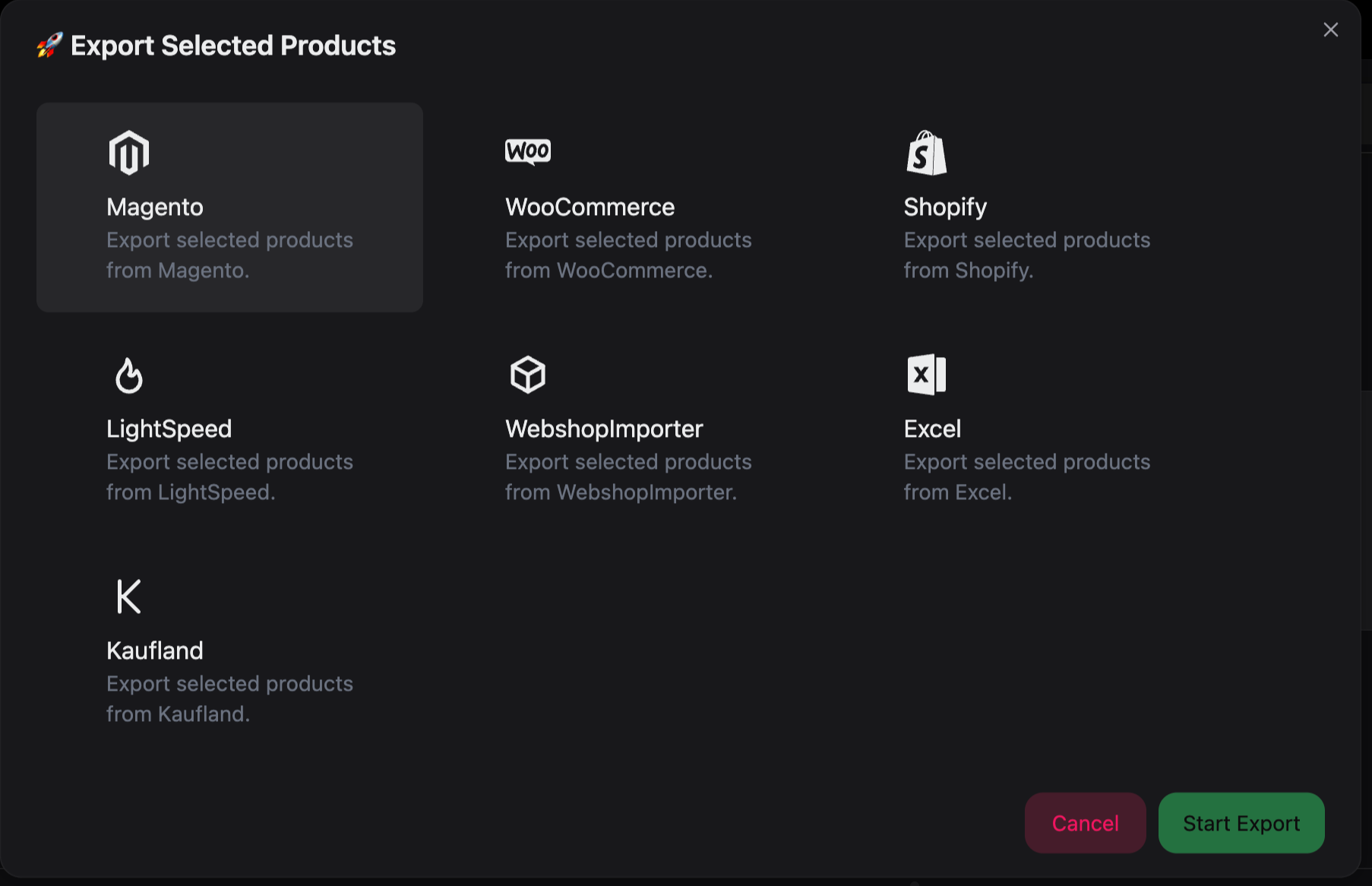Why a PIM system is essential for growing e-commerce businesses
PIM systems streamline product data handling, enabling e-commerce businesses to scale efficiently and maintain accurate, consistent information across multiple channels.

PIM System for Growth: Boosting E-commerce Scalability and Product Data Management
E-commerce businesses face unique challenges as they scale. Managing product data becomes increasingly complex with growth, potentially hindering expansion efforts. A robust Product Information Management (PIM) system is crucial for overcoming these obstacles.
By centralizing data management, PIM solutions help companies adapt to rapid growth while ensuring product information remains up-to-date and accessible.
As your product catalog expands, a PIM system becomes invaluable for organizing and distributing data effectively. It simplifies workflows, reduces errors, and allows you to focus on strategic growth initiatives rather than getting bogged down in manual data management tasks.
Key Takeaways
- PIM systems are essential for managing product data complexity during e-commerce growth
- Centralized data management improves accuracy and consistency across sales channels
- Implementing a PIM solution allows businesses to focus on strategic growth initiatives
Importance of PIM for E-Commerce Scale
Product Information Management (PIM) systems play a crucial role in e-commerce scalability and growth. They enable businesses to efficiently manage product data, enhance customer experience, and adapt to expanding sales channels.

The need for scalability in product data management
As your e-commerce business grows, so does the volume of product data you need to manage. A PIM system helps you handle this increased data load efficiently. You can easily add new products, update existing information, and maintain consistency across all channels.
PIM systems allow you to scale your product catalog without compromising data quality. You can manage thousands of SKUs, product variations, and attributes with ease. This scalability is essential for expanding into new markets or adding product lines.
By centralizing your product data, PIM systems eliminate data silos and reduce errors. This centralization ensures that all teams have access to accurate, up-to-date information, supporting your growth initiatives.
Facilitating Growth with PIM
PIM systems support your e-commerce growth by streamlining product data management processes. You can quickly onboard new products and enter new markets with minimal friction.
With a PIM system, you can:
- Automate data entry and updates
- Standardize product information across channels
- Easily adapt to new sales platforms and marketplaces
PIM systems also enable you to manage product data in multiple languages and currencies. This feature is crucial for expanding into international markets and reaching a global customer base.
By improving data accuracy and consistency, PIM systems reduce returns and customer complaints. This efficiency leads to increased customer satisfaction and loyalty, driving sustainable growth for your e-commerce business.

The Role of Product Data in Customer Experience
High-quality product data is essential for providing an excellent online shopping experience. PIM systems help you deliver accurate, detailed, and compelling product information to your customers.
With a PIM system, you can:
- Provide rich product descriptions
- Improve the quality of the information, which often leads to more sales
- Display accurate pricing and availability information
These elements help customers make informed purchasing decisions, reducing confusion and improving satisfaction. Detailed product data also helps with search engine optimization, making it easier for potential customers to find your products online.
PIM systems enable you to tailor product information for different sales channels and customer segments. This personalization enhances the customer experience and can lead to increased conversions and sales.
E-Commerce Scalability and Product Data Growth
As your e-commerce business expands, the volume and complexity of your product data increase exponentially. PIM systems are designed to handle this growth, ensuring your operations remain efficient and scalable.
PIM systems allow you to:
- Manage large product catalogs with ease
- Handle complex product relationships and variations
- Integrate with other e-commerce systems and platforms
By automating many aspects of product data management, PIM systems free up your team to focus on strategic initiatives rather than manual data entry. This efficiency is crucial for maintaining competitiveness in the fast-paced e-commerce landscape.
PIM systems also provide valuable insights into your product data, helping you identify trends and opportunities for growth. These insights can inform your product strategy and help you make data-driven decisions to scale your e-commerce business effectively.

Key Features of Effective PIM Systems
Effective Product Information Management (PIM) systems streamline operations, enhance data quality, and boost e-commerce performance. These systems offer robust capabilities to manage product data across multiple channels efficiently.
Integration Capabilities and ERP Connections
PIM systems excel at integrating with existing enterprise resource planning (ERP) software. This seamless connection allows for real-time data synchronization across your business operations. You can easily import product data from your ERP into the PIM system, ensuring consistency across all platforms.
Integration extends beyond ERPs to e-commerce platforms, marketplaces, and content management systems. This connectivity enables you to push updated product information to all sales channels simultaneously, reducing errors and saving time.
API support is crucial for custom integrations, allowing you to connect your PIM with specialized tools or proprietary systems unique to your business needs.
Improving efficiency with a PIM system
A PIM system centralizes your product data, eliminating the need for multiple spreadsheets or databases. This centralization speeds up product launches and updates across all channels.
You can create workflows within the PIM to automate approval processes and content creation tasks. This streamlines collaboration between teams, reducing bottlenecks in your product information management.
PIM systems often include digital asset management features, allowing you to store and organize product images, videos, and documents alongside text-based information. This integration simplifies content retrieval and ensures consistent brand representation.
Automation and Machine Learning Innovations
Advanced PIM systems leverage automation to handle repetitive tasks. You can set up rules to automatically categorize products, update attributes, or generate SKUs based on predefined criteria.
Machine learning algorithms can suggest product classifications, identify data inconsistencies, and even generate product descriptions. These AI-powered features help you maintain data quality at scale.
Automated data validation checks ensure that all required fields are filled and conform to set standards before products go live. This proactive approach minimizes errors and improves overall data accuracy.
Data Management and Quality Assurance
Effective PIM systems provide robust data governance tools. You can define data standards, set up validation rules, and track changes to maintain high data quality.
Version control features allow you to revert changes if needed and maintain a history of product information updates. This capability is crucial for compliance and auditing purposes.
Data cleansing tools help you identify and correct inconsistencies, duplicates, or outdated information in your product catalog. Regular data quality checks ensure that your product information remains accurate and up-to-date.
Product Information Collection and Data Enrichment
PIM systems offer various methods for collecting product data. You can import data in bulk, manually input information, or use web forms for suppliers to submit product details directly.
Data enrichment features allow you to enhance product descriptions with additional attributes, SEO keywords, or localized content. This enrichment improves product discoverability and relevance across different markets.
Some PIM systems include supplier portals where your vendors can directly update product information. This collaborative approach ensures that you always have the most current data from the source.
Advantages of Streamlined Data Management
Streamlined data management offers significant benefits for e-commerce businesses. It enhances efficiency, reduces errors, and improves customer experiences across multiple markets and languages.
Enhancing Operational Efficiency and Time-to-Market
Streamlined data management boosts your operational efficiency. You'll process product information faster, reducing the time it takes to launch new items. With centralized data, you can quickly update product details across all sales channels. This speed allows you to respond rapidly to market trends and customer demands.
Your teams can collaborate more effectively when working from a single source of truth. Marketing, sales, and logistics departments access the same up-to-date information. This alignment minimizes miscommunication and accelerates decision-making processes.
By streamlining your workflow, you'll notice a significant reduction in time-to-market. New products can be introduced more quickly, giving you a competitive edge.
Reducing Manual Data Entry with PIM Automation
Automation in Product Information Management (PIM) systems drastically cuts down on manual data entry. You'll save time and resources previously spent on repetitive tasks. PIM tools can automatically populate fields, validate data, and update information across platforms.
This automation reduces human error, ensuring your product data is more accurate and consistent. You'll spend less time correcting mistakes and more time on strategic tasks that drive growth.
PIM systems often include bulk editing features. You can make changes to multiple products simultaneously, further increasing efficiency. This is especially valuable when managing large catalogs or during seasonal updates.
Supporting Multilingual Product Information with Localization
Expanding into global markets becomes more manageable with streamlined data management. PIM systems often include features to support multiple languages and localization efforts. You can manage translations within the same system, ensuring consistency across all markets.
Centralized translation management allows you to:
- Store and reuse translated content
- Track translation progress
- Maintain version control for different languages
This approach simplifies the process of launching products in new markets. You can quickly adapt your offerings to local preferences and regulations without starting from scratch each time.
The Impacts of Data Consistency on User Experience
Consistent product data significantly enhances user experience across all your sales channels. When customers encounter the same accurate information whether they're shopping on your website, mobile app, or through a marketplace, it builds trust and confidence in your brand.
Accurate and up-to-date product details lead to:
- Fewer customer inquiries and returns
- Increased customer satisfaction
- Higher conversion rates
Consistent data also improves your search engine optimization efforts. Search engines favor websites with coherent, high-quality content, potentially boosting your visibility in search results.
By maintaining data consistency, you create a seamless omnichannel experience. Customers can easily switch between devices or platforms without confusion, leading to smoother purchasing journeys.
Data Governance and Standards
Effective data governance and standards are crucial for managing product information at scale. Implementing robust practices ensures data quality, consistency, and reliability across your e-commerce operations.
Implementing Data Quality Control
Data quality control is essential for maintaining accurate product information. Establish clear guidelines for data entry and validation processes. Implement automated checks to flag inconsistencies or missing details. Regular audits help identify and correct errors promptly.
Create a data quality scorecard to track key metrics. This can include completeness, accuracy, and timeliness of product data. Set up alerts for when data falls below defined thresholds.
Train your team on best practices for data management. Assign data stewards to oversee specific product categories or attributes. This ensures accountability and expertise in maintaining high-quality data.
Data Modeling and Master Data Management
Develop a comprehensive data model that reflects your product structure and relationships. Define clear hierarchies, attributes, and relationships between product entities. This forms the foundation for effective master data management.
Implement a centralized master data management system. This serves as the single source of truth for all product information. Ensure it integrates seamlessly with your PIM and other e-commerce systems.
Create standardized taxonomies and ontologies for product classification. This improves searchability and enables consistent categorization across channels. Use industry-standard product identifiers where applicable to enhance interoperability.
Establish governance policies for data creation, modification, and deletion. Define roles and permissions to control access to sensitive product information. Regular reviews of these policies help maintain data integrity and security.
Multi-Channel Marketing and Sales Channel Distribution
Effective multi-channel strategies expand your reach and drive growth. Tailoring products and managing inventory across channels maximizes sales opportunities and customer satisfaction.
Product Customization and Personalization
Product customization allows you to meet diverse customer needs across different channels. Offer configurable options on your website, letting buyers choose colors, sizes, or features. In physical stores, provide personalization services like engraving or custom fittings.
Use data from your PIM system to recommend relevant products based on browsing history. Implement dynamic pricing to adjust offers for each channel. Create channel-specific product bundles or exclusive items to drive engagement.
Consider using augmented reality tools to let customers visualize customized products before purchase. This works well for furniture, apparel, and accessories across digital platforms.
Inventory Management and Promotions
Centralize inventory data in your PIM system for real-time visibility across all channels. Set channel-specific stock levels and reorder points to prevent stockouts. Use automated replenishment to maintain optimal inventory at each location.
Implement cross-channel promotions to drive traffic between platforms. Offer in-store pickup for online orders to blend digital and physical experiences. Use geolocation to send targeted mobile promotions when customers are near your stores.
Create urgency with limited-time offers on social media. Showcase bestsellers and new arrivals prominently across channels. Use your PIM data to identify slow-moving items and create promotions to boost their sales.
Impact of PIM on Business Outcomes
Product Information Management systems drive tangible business results across multiple areas. They enhance competitiveness, strengthen online visibility, and provide data-driven insights for better decision making.
Achieving Competitive Edge and Brand Image
PIM systems give you a competitive advantage by ensuring your product information is accurate and up-to-date. This reliability builds trust with customers and strengthens your brand image. You can easily maintain consistency across all sales channels, presenting a unified brand voice.
PIM enables faster time-to-market for new products. You can quickly update and distribute product information, staying ahead of competitors. This agility is crucial in fast-paced markets.
By providing rich, detailed product content, you differentiate your offerings. Customers make more informed decisions, leading to higher satisfaction and fewer returns. This positive experience reinforces your brand's reputation for quality and customer-centricity.
Bolstering Online Presence and Organic Traffic
PIM systems significantly boost your SEO efforts. By managing product data centrally, you ensure consistency in keywords, descriptions, and metadata across your e-commerce platform. This consistency improves search engine rankings and visibility.
You can easily create and maintain product-specific landing pages with optimized content. These pages attract targeted organic traffic, increasing your online presence. PIM allows you to quickly adapt product information for different markets and languages, expanding your reach.
Rich product content managed through PIM systems encourages longer site visits and lower bounce rates. These factors positively influence search rankings, creating a virtuous cycle of improved visibility and traffic.
Analytics and Insights for Strategic Decisions
PIM systems provide valuable analytics on product performance and customer interactions. You gain insights into which product attributes drive sales and which may need improvement. This data helps you refine your product strategy and focus on high-performing items.
You can track how changes in product information affect sales and customer engagement. This allows for data-driven optimization of product descriptions, images, and other content. PIM analytics also help identify trends and opportunities in different market segments.
By integrating PIM data with other business systems, you create a comprehensive view of your operations. This holistic perspective enables more informed strategic decisions about inventory, pricing, and product development.
PIM Best Practices and Considerations
Implementing effective Product Information Management (PIM) practices is crucial for e-commerce success. Selecting the right system, fostering collaboration, and ensuring adaptability are key factors to consider.
Choosing a PIM System Suited for Growth
When selecting a PIM system, focus on scalability and future needs. Look for solutions that can handle increasing product data volumes and complexity. Consider systems with robust API capabilities to integrate with your existing tech stack.
Evaluate the system's ability to support multiple channels and markets. This flexibility will be vital as your business expands. Ensure the PIM can accommodate various product types and attributes relevant to your industry.
Assess the system's performance under heavy loads. A scalable PIM should maintain speed and efficiency even as your product catalog grows. Look for features like bulk editing and automated workflows to streamline operations.
Team Collaboration and Central Hub Functionality
A PIM system should serve as a central hub for product information, fostering collaboration across departments. Choose a solution with user-friendly interfaces and role-based access controls to manage permissions effectively.
Look for features that support real-time collaboration, such as commenting, task assignment, and version control. These tools help teams work together efficiently on product data management.
Consider PIM systems with built-in workflow management. This feature can help streamline approval processes and ensure data accuracy. Integrated analytics can provide insights into team productivity and data quality.
Future Proofing Through PIM Adaptability
To future-proof your PIM investment, prioritize systems with regular updates and a strong development roadmap. Look for vendors committed to enhancing their product in line with industry trends.
Consider PIM solutions with AI capabilities. These can automate tasks like data enrichment and quality control, saving time and improving accuracy. AI-powered features can also help optimize product descriptions for better search visibility and conversion rates.
Ensure the PIM system can adapt to changing market needs. Look for flexibility in adding new attributes, channels, or integrations. This adaptability will help your business stay competitive in a rapidly evolving e-commerce landscape.
Global Commerce and PIM
PIM systems play a crucial role in enabling businesses to expand globally and manage product information across diverse markets. They streamline processes for handling multiple currencies, localization, and coordinated product launches worldwide.
Dealing with Multiple Currencies and Localization
A robust PIM system helps you manage pricing in various currencies effortlessly. It allows you to set base prices and automatically convert them to local currencies using up-to-date exchange rates. This feature ensures accurate pricing across all your global storefronts.
Localization goes beyond currency conversion. Your PIM should support multiple languages, allowing you to store product descriptions, attributes, and metadata in different languages. This capability enables you to tailor product information to specific markets, improving customer experience and boosting sales.
Consider using language-specific attributes for products that may have different names or descriptions in various regions. A good PIM system will help you maintain consistency across translations while accommodating local nuances.
The importance of consistency and speed in product launches
Consistency is key in global product launches. Your PIM system should act as a single source of truth for all product information. This centralization ensures that all channels and markets receive the same accurate data.
Speed is equally crucial. A well-configured PIM allows you to update product information quickly across all platforms. This agility is vital in responding to market changes or correcting errors.
Use your PIM to create standardized templates for product launches. These templates can include all necessary attributes, ensuring no critical information is missed when introducing new products.
Global Product Launches and Information Dissemination
Coordinating global product launches becomes more manageable with a PIM system. You can schedule releases and control when information becomes available in different markets.
Your PIM should allow you to set up workflows for approving and publishing product data. This feature ensures that all necessary checks are completed before information goes live.
Use your PIM to track which products are available in which markets. This visibility helps you manage inventory and plan marketing strategies more effectively.
Consider integrating your PIM with other systems like ERP or CRM to streamline the entire product launch process. This integration can help you align stock levels, pricing, and customer data across your global operations.
Overcoming Challenges with PIM
Implementing a Product Information Management (PIM) system can present hurdles, but with the right strategies, you can overcome them effectively. Addressing data silos and inconsistencies are key to maximizing PIM benefits.
Breaking Down Data Silos and Ensuring Data Integration
Data silos can hinder your PIM system's effectiveness. To break them down, start by mapping out all your data sources. Identify where product information is stored across departments and systems.
Create a centralized data hub within your PIM. This will serve as the single source of truth for all product information. Implement APIs and connectors to facilitate seamless data flow between your PIM and other systems.
Establish clear data governance policies. Define roles and responsibilities for data management across your organization. This ensures everyone knows their part in maintaining data integrity.
Train your team on the importance of data integration. Help them understand how breaking down silos benefits the entire organization. Encourage cross-departmental collaboration to improve data sharing and quality.
Addressing Product Data Inconsistencies
Inconsistent product data can lead to customer confusion and lost sales. Start by auditing your existing product information. Identify common inconsistencies in descriptions, specifications, and pricing.
Implement data validation rules in your PIM system. This helps catch errors before they enter your database. Use automated tools to standardize product attributes like units of measurement and color names.
Create clear guidelines for product data entry. Ensure all team members follow the same format and style. This promotes consistency across your product catalog.
Regularly review and clean your product data. Set up automated alerts for potential inconsistencies. Assign team members to address these issues promptly.
Consider using machine learning algorithms to detect and correct data anomalies. This can help you maintain high-quality product information at scale.
October 3, 2024

CTO and Co-Founder at WISEPIM, building AI-powered solutions that transform product data management for e-commerce businesses. Over 10 years of experience solving complex technical challenges in e-commerce and PIM systems.